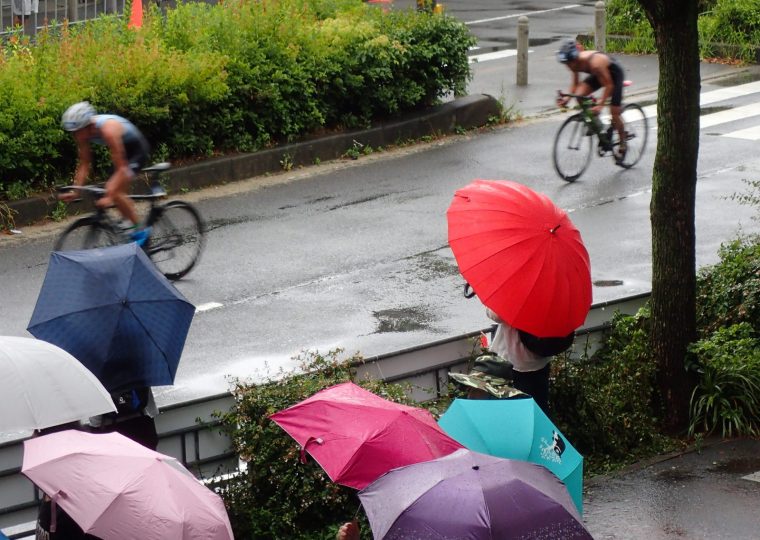
I’m not quite sure what possessed me to sign up for the inaugural Osaka Castle Triathlon. I had done the previous JTU Osaka Triathlon in the mouth of the Yodo River on reclaimed islands and vowed never to return. However, the thought of swimming in the castle moat was strangely appealing – how else would I ever get the chance to swim in a 450-year-old moat? We were assured on the website that the water had been checked last year and had scored 3 points on a 5-point scale of water suitable for swimming. I tried not to think about what had ended up in that water over the last 450 years and registered for the race.
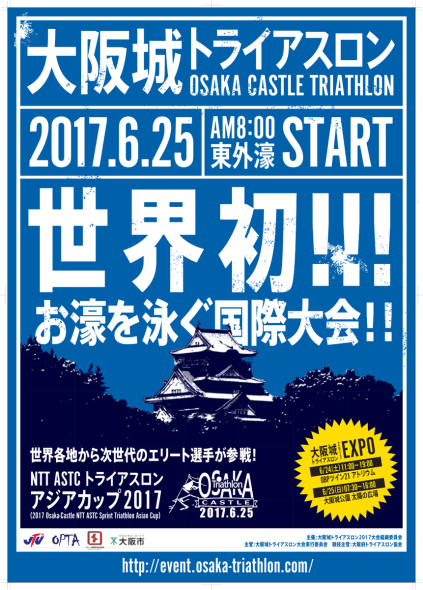
It turned out that the worries about the moat swim were a bit of a diversion from the real issue with the course – the bike leg. As with other races with a dodgy bike course, the details only emerge once you have signed up. The Centrair 70.3 organisers are always very slow to reveal their consistently ill-conceived courses until the last minute, and so it proved with OCT. A few weeks before the race we learnt that it was either going to be 9 laps or 10 laps (depending on whether you read the Japanese or the English version) of a tortuous course through the castle park. I decided to take my road bike.
 The dark green waters of the moat
The dark green waters of the moat
I arrived at the castle on Saturday afternoon with plenty of time before registration to carefully check the course. The moat was as green and murky as you would expect, but at least I couldn’t see any shopping trolleys poking out of the slime. Transition was very confusing: it was stretched out along a couple of curving paths beneath a dense cover of trees, with no clear way in or out. I used the course map on my phone to work out the bike route, and slowly cycled through the Saturday afternoon crowds to inspect its every twist and turn. It didn’t look good. In fact, it looked very bad. At many points the course changed from pavement to road and back to pavement, with small steps at each juncture. This is bad enough in a race, but most of these points were on sharp bends. If this wasn’t a recipe for disaster, there was much worse to come. On several of the bends there was dirt and soil on the road, just waiting for Sunday’s promised rain to turn into mud. At one point, the course cut through the edge of a building site to get out on to the only straight part of the course along a railway. This part was bumpy, muddy, and treacherous.
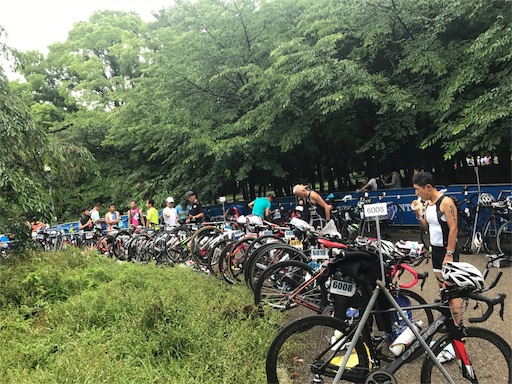 T in the Park
T in the Park
I met Tim in the park and we went together to the English race briefing in the huge foyer of the Twin 21 Building. We met Alf, Keren and Makiko and settled down for the English briefing…which was in Japanese. It seems that they had overlooked the international billing of the race and forgotten that they had advertised an English briefing. Our JTU friend Tomoko did the honours and translated for us. The main thing we learnt from the briefing was that the water temperature was 28°C. Why they couldn’t have posted this on the website so we could pack sleeveless wetsuits is just one more of life’s JTU-related mysteries.
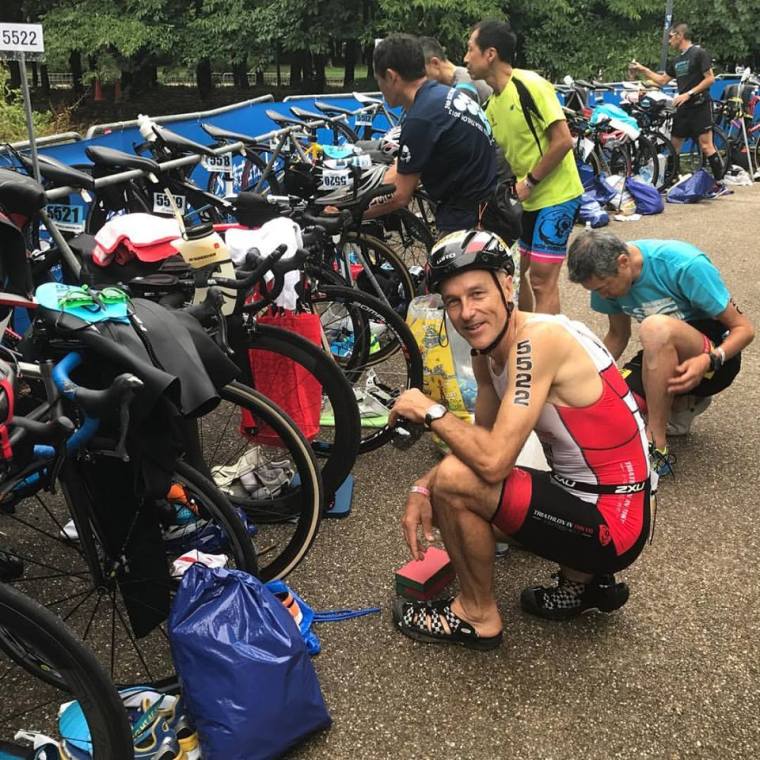
The next morning, I cycle through the deserted streets of Osaka with the promised rain not yet falling. Despite being 2 hours early, transition was already pretty full, so I squeezed my bike into the designated spot next to Keren and got ready for start. Most of the fastest people in my age group were there, including Hirata-san and Yamano-san, who were one-two at Yokohama. As this was my warm-up race for the Asian Championships in Sokcho, I would settle for third.
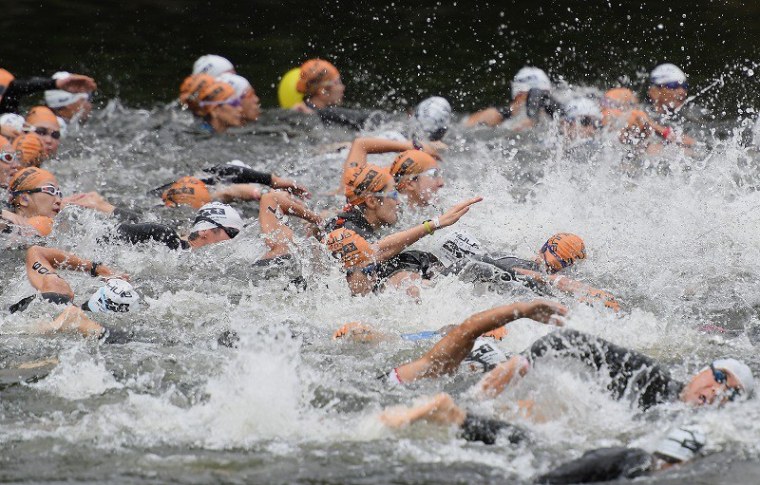 The Start of the Swim
The Start of the Swim
The first few waves set off around 8 o’clock and appeared to survive the challenges of the moat. At 9 o’clock, Keren, Tim, and I lined up for our turn. The starter klaxon sounded and we were off. As usual, I swam wide to the left, beneath the looming castle walls, with someone clipping my heels for the first few strokes. I focused on keeping my heart-rate low and my temperature down in the balmy water. It seemed like a good race to work on my form and let others power ahead. A few times the heat started to overwhelm me, so I slowed my stroke even further, and concentrated on all my coach’s advice: reach further forward for the catch, rotate the hips, high elbow, keep the hand relaxed and vertical all the way to the back of the stroke. It helped to take my mind off what might lurk beneath the gloomy waters.
 Our wave returning
Our wave returning
After all the concerns, the moat swim was fine. The water seemed better than races like Yokohama, and of course it was flat. Sighting was easy, and there was no congestion at all. Best of all, there was so much support that you could clearly hear the cheers as you swam by. I climbed the exit stairs expecting a slow time, but my watch showed 24:58. That put a smile on my face. I ran to transition and spotted Keren just ahead, so he had also had a good swim. We exchanged a few words in transition and I was off for the bike.
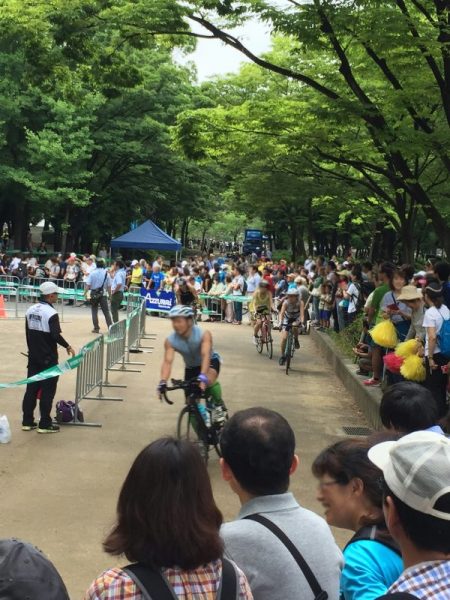 Narrow, winding, bumpy, slippery, and wet
Narrow, winding, bumpy, slippery, and wet
From Saturday’s course inspection, I knew what to expect from transition – a series of tight bends on bumpy tracks. No one had thought to sweep the paths, so all the patches of soil and loose grit were still there, but at least it wasn’t raining. At the first bend, there was a young guy writhing in pain on the floor, his bike tangled beneath him. I took the bend wide and continued. For the next 8 laps I raced well. I slowed for the bends, avoided the mud and potholes and weaving slower bikes, and then kept a steady 40-41 km/h on the straights. I was having my best bike leg for ages. All the commuting to and from work on my touring bike with a heavy pannier was paying off. Apart from the treacherous winding section through the trees, there was surprisingly little bunching on the course. The straight sections along the railway were wide and many of the curving park roads had space to pass.
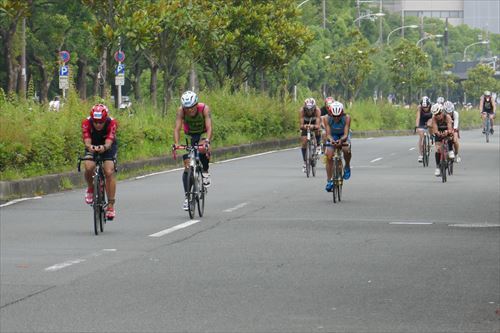 The fast section of the course
The fast section of the course
On the eighth lap, light rain started to fall. Water dripped from the trees on to the narrow paths, and the officials energetically waved their arms and shouted “slow down”. It brought to mind the slow bicycle races of my childhood where the aim was to cross the line last without putting your feet down. It also made me wonder why they hadn’t put a little of that energy into sweeping the dirt off the bends rather than watching rider after rider take a fall. At one bend, a woman around 70 was lying bruised and bloody; my stomach lurched. At the next bend it was me. I had slowed right down for the entrance to the building site, but clearly not enough. I hit the ground hard, but didn’t feel anything crack. I got up sore but in once piece and wheeled my bike to the edge of the course. Rather than helping me back on to the bike, two officials tried to drag me further off the course. My chain was jammed in the derailleur, and all they managed to do was to jam it further. They manhandled me off the course and then tried to take my bike away. Clearly they thought I should retire, but I had other ideas. My derailleur was twisted so I bent it roughly back into position. I replaced the chain, and then found both brakes jammed. I centred them, checked the wheels spun, and jumped back on the saddle. My handlebars were twisted to the right, and my aero bars were bent right up under my chin. It was a very strange riding position, but I had less than a lap to go so I would manage. I was soon passing all the people who had ridden round me lying on the ground.
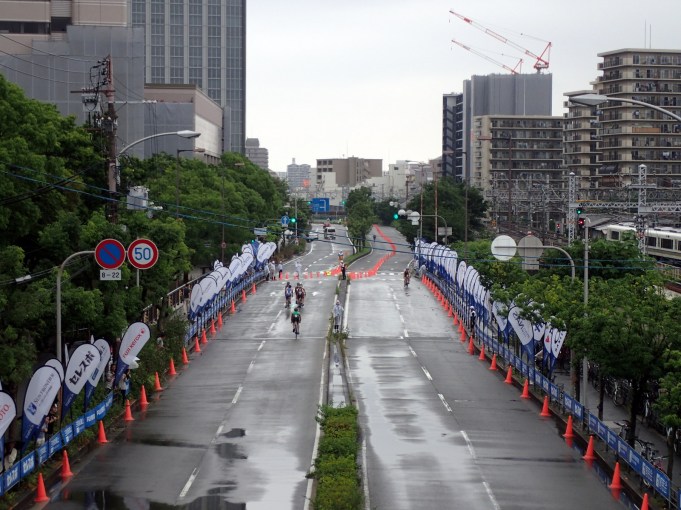 Elite racers in the Asian Sprint Championship race
Elite racers in the Asian Sprint Championship race
Hirata-san’s bike was in our section of transition, so I was in second. I started the run with aches and pains everywhere, but it seemed I could continue. My hip was sore, but something is always sore, so I ran on through the cheering crowds. There was great support all along the course, despite the rain. My bloodied wounds got a lot of stares, but my Garmin showed they weren’t slowing me too much. At the first turnaround, the adrenaline was waning, and the pain started to ratchet up. I started to think about retiring, but then spotted Yamano-san running smoothly a couple of hundred metres back. I decided to try to hold on to second. On the next lap, he was a bit closer, but then I was overtaken by a female race, Onishi-san, who soon became my pacemaker for the rest of the race. She pulled way, but then I dragged back the metres. She pulled away, and I held on to her ankles. At the next turnaround, the gap back to Yamano was the same. I passed Keren and Tim going the other way, and they both shouted encouragement. I didn’t really need it – I just wanted to get over the line and into the medical tent.
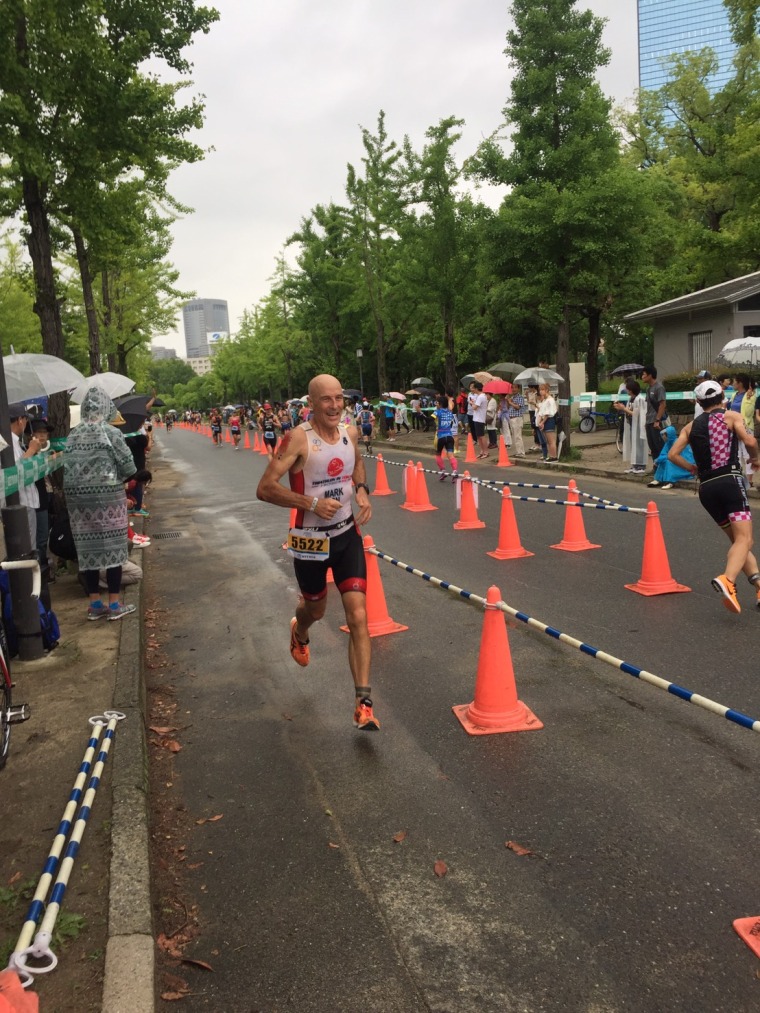 Into the finishing chute
Into the finishing chute
I ran up a deserted finishing chute, broke the tape, and limped straight into the medical tent. I sat amongst a line of similarly injured people all yelping as the staff splashed alcohol onto their wounds. For me it was a bit of a relief from the pain in my hip. They then put Vaseline on the worst bits, covered them with cling film, and sent me on my way.
 Still smiling…
Still smiling…
Back outside I met Yamano-san who insisted I had won our age group, which was a surprise. It turned out that Hirata had retired after the swim. I then met Keren, who had raced well and got some valuable ranking points which will help with qualification for the worlds next year in the Gold Coast. Tim had got a new personal best and Alf also seemed pleased with his time. Unfortunately, I had to rush off to see Miki performing with her sanshin back home in Hayama.
Post-race Thoughts
It is hard not to be frustrated with the JTU for designing such a dangerous course. It is not a local, amateur organisation, but a national sporting body responsible for one of the showcase Olympic events. Keren and I had mentioned the mud on the course to one official, but we just got laughter in return. It wasn’t a case of whether someone would fall, but of who it would be. I was unlucky to be one of the many fallers, but at least I had not broken anything. I put this down to the luck of not landing on one part of my body. In fact, I have road rash on my ankle, calf, knee, hip, wrist, elbow, shoulder, and back. It is quite a collection. My ankle is swollen, my hip bruised, and my shoulder sore. However, I have learned how to properly dress road rash. I bought a selection of lint squares, paper-based tape, mesh tube bandages, Vaseline, swabs, and alcohol from the chemist. Vaseline applied to the wounds with a swab stops the lint sticking, and the paper tape rips out fewer hairs when you remove it. The mesh bandages are good for elbows and knees. If the lint won’t come off in the shower, you can use a swab dipped in alcohol to ease it off. I’ve been icing down my ankle with an excellent Zamst icing wrap. However, despite all my efforts, Sokcho is looking increasingly unlikely.
I got an email on Monday from the race organisers thanking me for my participation and proudly stating their aim to put Osaka on the world triathlon circuit. It definitely has a lot of potential, but they really need to listen to the voices of the triathletes, especially those who fell on Sunday. There doesn’t seem to be any need to put the bike course through the winding section – maybe they thought it would be fun for us. As someone who has ridden a road bike for 35 years without falling, I would rather opt for a simple, straightforward course.
